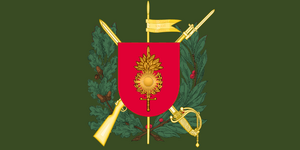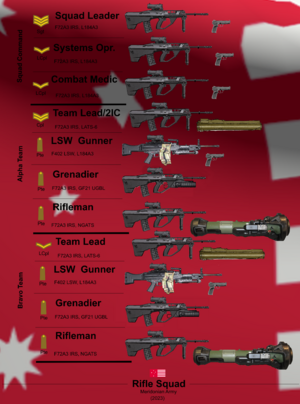Meridonian Army: Difference between revisions
No edit summary |
|||
| Line 79: | Line 79: | ||
===Structure=== | ===Structure=== | ||
[[File:MA_Rifle_Squad.png|thumb|Organization of a Meridonian army rifle squad, circa 2023.]] | |||
All non-special forces land combatant units are organized under Army Forces Command. AFC consists of two non-operational organizations- Forward Forces Command (FFC), responsible for forward-oriented or actively deployed units; and Home Forces Command (HFC), which manages units directly tasked with maintaining homeland defense. The army consists of a total of 8 maneuver regiments, including one airborne, one armored, three mechanized and three light. These regiments, when deployed, will fall under the 2 divisions in FFC- 2 Division and 6 Division. Only 2 regiments are permanently assigned to FFC- these being [[4 Regiment Airborne]] in 2 Division and [[11 Regiment Taumako Light]] in 6 Division. Both of these units are considered as special operations forces. These divisions rotate regimental assignments regularly on an as-needed basis to suit deployments and national defense needs. HFC is also home to 3 Division, which administers the reserve component of the Army; and 1 Division, which maintains all permanent and semi-permanent home defense assets, including all non-deployed maneuver regiments. HFC is further delineated into several military districts, which are joint MDF commands and serve as the next highest operational level above the brigade, as 1 Division is not an operational organization. | All non-special forces land combatant units are organized under Army Forces Command. AFC consists of two non-operational organizations- Forward Forces Command (FFC), responsible for forward-oriented or actively deployed units; and Home Forces Command (HFC), which manages units directly tasked with maintaining homeland defense. The army consists of a total of 8 maneuver regiments, including one airborne, one armored, three mechanized and three light. These regiments, when deployed, will fall under the 2 divisions in FFC- 2 Division and 6 Division. Only 2 regiments are permanently assigned to FFC- these being [[4 Regiment Airborne]] in 2 Division and [[11 Regiment Taumako Light]] in 6 Division. Both of these units are considered as special operations forces. These divisions rotate regimental assignments regularly on an as-needed basis to suit deployments and national defense needs. HFC is also home to 3 Division, which administers the reserve component of the Army; and 1 Division, which maintains all permanent and semi-permanent home defense assets, including all non-deployed maneuver regiments. HFC is further delineated into several military districts, which are joint MDF commands and serve as the next highest operational level above the brigade, as 1 Division is not an operational organization. | ||
Revision as of 18:45, 19 May 2023
| Meridonian Army | |
|---|---|
 Service flag of the Meridonian Army | |
| Active | 06 May 1739 - present |
| Country | |
| Type | Army |
| Role | Land warfare |
| Size | 106,482 |
| Part of | |
| Ceremonial Garrison | Greycreek Barracks, Alexandria |
| Motto(s) | Through Valor, Liberty |
| Colors | Ranger Green, Army Gold |
| March | Over the Hills and Far Away |
| Engagements | Second Meridonian Civil War |
| Commanders | |
| Commander-in-Chief | William Acton |
| Defense Secretary | Jason Merritt |
| Army Secretary | Alan Pierro |
| Chief of Defense Staff | Gen John Argus |
| Chief of Army Staff | Gen Arthur McCann |
| Vice Chief of Army Staff | LGen Kenneth Bradston |
| Army Sergeant Major | Vincent Campbell |
| Insignia | |
| Service badge |  |
| Aircraft roundel |  |
| Alternate low-vis roundel |  |
The Meridonian Army is the land warfare component of the Meridon Defense Forces. It is composed of 106,482 active duty troops, and about 50,000 reservists as of 2022. It is the largest service branch in the Meridon Defense Forces.
The Meridonian Army, taking its roots from European and specifically English influences, was in its modern founded in 1739 by the Union Council in order to fight the Second Meridonian Civil War against the Sovereignist coalition, however it traces its origins back to the militia units of the original European citystates. The Army, along with the Meridonian Navy, existed as independent forces without a real unified command structure until 1833, where it was subordinated under the War Office alongside the Navy. A need for greater joint forces command, realized during the Second World War, resulted in the restructuring of the armed forces and the establishment of the Meridonian Defense Forces and the Defense Department.
The Army in its modern day form is a fully professional fighting force. It, alongside the rest of the Armed Forces (excluding the Air Forces and their predecessor, the Army Air Forces) conducted mandatory conscription from 1934 to 1960, but has since been able to maintain sufficient numbers through volunteers alone. The Army is designed around high mobility and expeditionary warfare, and has a good mix of unit capabilities to meet this goal. It is administered by the Department of the Army as a civilian oversight agency. It is commanded, however, by the Chief of Army Staff,a 4 star officer and the seniormost commissioned officer in the Army. It regularly conducts operations and exercises along other nations, including peacekeeping and training exercises.
History
Early Iterations
Formation
1800's
Early 1900's
Post-war
Modern day
Organization
The Army consists of two components- Regular and Reserve. Regular formations compose the active-duty formations of the Army and comprise the majority of its strength, including all of its deployable brigades. Reserve formations consist of both part time soldiers and lower readiness formations that are generally relegated to defense support activities on an as-needed basis. Reserve soldiers, at a minimum, conduct training two days per month with their formation and three weeks of annual training a year.
The Army is headed by the Chief of Army Staff, the highest-ranking commissioned officer in the Army, who sits on the Defense General Staff as its seniormost representative. The COAS reports to the Army Secretary, who reports to the Defense Secretary, who primarily advises the President of Meridon on all defense matters and is responsible for implementing civilian policy into the Army.
Structure
All non-special forces land combatant units are organized under Army Forces Command. AFC consists of two non-operational organizations- Forward Forces Command (FFC), responsible for forward-oriented or actively deployed units; and Home Forces Command (HFC), which manages units directly tasked with maintaining homeland defense. The army consists of a total of 8 maneuver regiments, including one airborne, one armored, three mechanized and three light. These regiments, when deployed, will fall under the 2 divisions in FFC- 2 Division and 6 Division. Only 2 regiments are permanently assigned to FFC- these being 4 Regiment Airborne in 2 Division and 11 Regiment Taumako Light in 6 Division. Both of these units are considered as special operations forces. These divisions rotate regimental assignments regularly on an as-needed basis to suit deployments and national defense needs. HFC is also home to 3 Division, which administers the reserve component of the Army; and 1 Division, which maintains all permanent and semi-permanent home defense assets, including all non-deployed maneuver regiments. HFC is further delineated into several military districts, which are joint MDF commands and serve as the next highest operational level above the brigade, as 1 Division is not an operational organization.
Supporting forces, including medical, intelligence, and procurement, are organized under Joint Support Force Command (JSFC). Army special forces are organized under the Army Special Forces Group (ASFG), which is subordinated to the Joint Special Forces Group (JSFG), a tri-service organization of special forces units.
Headquarters, Army (HQA)
- Army Forces Command (AFC)
- Army Reserve Command (ARC)
- Joint Support Force Command (JSFC)
- Army Training and Readiness Command (TREDCOM)
- Army Medical Command (MEDCOM)
- Army Procurement Command (PROCOM)
- Army Enforcement and Investigations Command (EICOM)
- Army Engineering Corps (AEC)
- Army Intelligence and Cyberwarfare Command (INCYCOM)
- Army Aviation Command (AVICOM)
- Army Integrated Air Defense Command (IADECOM)
- Army Personnel Command (PERSCOM)
- Cordelia Military District
- Army Funerary Command/ Federal Memorial Segrano Hill
- 1 Regiment Federal
Special operations forces
See also:Special Operations Forces Command
Special warfare forces are organized under the Army Special Forces Group (ASFG), which regularly interoperates and reports to Special Operations Forces Command (SOFCOM). ASFG consists of a number of tenant special forces unit.
Equipment
See also:Modern equipment of the Meridonian Army
Uniforms
Personnel
See also:Military ranks of the Meridon Defense Forces#Meridonian Army
Commissioned officers
| DD Pay Grade | OF11 | OF10 | OF9 | OF8 | OF7 | OF6 | OF5 | OF4 | OF3 | OF2 | OF1 | OFC |
|---|---|---|---|---|---|---|---|---|---|---|---|---|
Army |

|

|

|

|

|

|

|

|

|

|

|
Various |
| Rank title | Field Marshal | General | Lieutenant General | Major General | Brigadier | Colonel | Lieutenant Colonel | Major | Captain | Lieutenant | Second Lieutenant | Various |
| Abbrevation | FM | Gen | LGen | MGen | Bdr | Col | LCol | Maj | Cpt | Ltn | 2Lt | Various |
Other ranks
| DD Pay Grade | WO1 | WO2 | WO3 | WO4 | WO5 | OR6 | OR5 | OR4 | OR3 | OR2 | OR1 | Recruit | ||||
|---|---|---|---|---|---|---|---|---|---|---|---|---|---|---|---|---|
Army |

|

|

|

|

|

|

|

|
No rank insignia | No rank insignia | ||||||
| Rank title | Warrant Officer Class 1 | Warrant Officer Class 2 | Warrant Officer Class 3 | Warrant Officer Class 4 | Warrant Officer Class 5 | Staff Sergeant | Master Sergeant | Color Sergeant | First Sergeant | Technical Sergeant | Sergeant | Corporal | Lance Corporal | Private | Recruit | |
| Abbrevation | WOC1 | WOC2 | WOC3 | WOC4 | WOC5 | SSgt | MSgt | CSgt | 1Sgt | TSgt | Sgt | Cpl | LCpl | Pte | Rct | |




